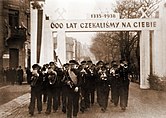Portal:Poland/Selected article/16
Zaolzie (Czech: Zaolší) is a historical region on the left bank of the Olza River on the Czech–Polish border. Historically part of the Duchy of Teschen (Cieszyn, Těšín), it belonged to Austria-Hungary until its dissolution in 1918. Afterwards, it became a bone of contention between the nascent republics of Poland and Czechoslovakia. The region, inhabited by ethnic Poles, Czechs and Jews, was rich in coal and crossed by a strategic railway linking Czech Silesia with Slovakia. Agreements between local authorities, armed fighting and an ettempted plebiscite proved inconclusive and in 1920 the Council of Ambassadors settled the matter at the Spa Conference by awarding Zaolzie to Czechoslovakia. In 1938, Poland issued an ultimatum to its southern neighbor to withdraw from Zaolzie within 24 hours, and the following day Czechoslovakia complied. Poland annexed the region and became seen as an accomplice in the partition of Czechoslovakia resulting from the Munich Agreement. Zaolzie was annexed by Nazi Germany after the German invasion of Poland a year later and returned to Czechoslovak hands with the end of World War II. Today the area is part of the Czech Republic and home to about 37,000 ethnic Poles. After 2001, several villages in the region have erected bilingual signs in Czech and Polish. (Full article...)

